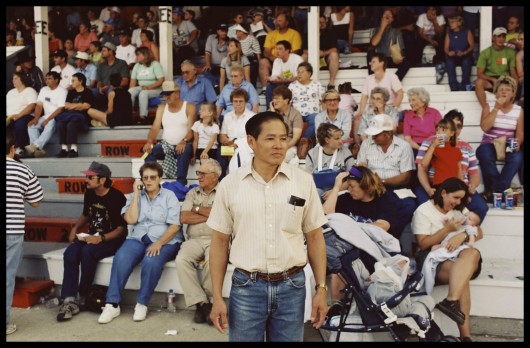
Wing Young Huie:
I had never been to rural Montana. When we first pulled into Baker, it resembled a scene from an apocalyptic movie: tidy, rustic shops lined main street, but where was everybody? A lone soul finally appeared to inform us that the demolition derby was in town. Apparently the entire populace of Baker was at this car-as-gladiator spectacle.
An accommodating elderly gentleman in a cowboy hat excitedly explained the intricacies of the sport to us. The sight and sounds of smashing metal contrasted with the languorous audience and its intermittent cheers. In many ways, it didn’t seem all that different from a crowd at a baseball game back in the Twin Cities.
When my attention turned to photographic possibilities, I was excited to spy one of the only Asian faces in this communal gathering. This man and his wife, both Cambodian, blended right in with their dress and deportment. But to me, he still looks Photoshopped into this picture. I wonder, is that what I, also an Asian American, look like walking around the land of Lake Wobegon—as though I’ve been Photoshopped into the landscape?
Doug Hartmann:
This was one of the first photos Wing and I work-shopped publicly as we began the Changing Lenses project. On that winter night, I told the crowd that I liked the idea of this photograph as much as the image itself. It so powerfully and succinctly captured the reality of an increasingly diverse, multicultural America. As I put it then: “What could be more mainstream, Midwest, Heartland-America than a demolition derby?” And yet, here in the midst of this quintessentially middle-American spectacle was an Asian American man.
I think I went on to talk about the paradoxes, complexities, and peculiarities of America and race—giving examples from my own projects, Wing’s portfolio, and other scholarly research. I think I talked about the tensions between our easy celebration of diversity and the problems and inequalities that persist even in the face of these differences—what my colleague Joyce Bell and I have called America’s “happy talk” about diversity. I think I even brought up the question of whether Americans’ encounters with racial others serve to break down traditional racial and ethnic boundaries or simply reinforce them.
But honestly, what I most remember about the event was not what either of us said about this photo, it was the audience response. They had vast and radically contrasting things to say. People talked about class differences and rural/urban contrasts, pointed out the different levels of interest and attention among the spectators, and expressed extremely different views on the Asian man himself. Some saw him as alienated and out of place, others thought he looked so confident and self-assured he might be in charge of the whole operation. One audience member looked into the background and took the conversation into the controversies surrounding public breastfeeding, while another spotted a woman in the crowd and simply pointed out that she looked like his grandmother, so he felt kind toward her.
This conversation reminded me that diversity isn’t just a socio-demographic phenomenon, but that there is a diversity of opinion in the various ways people see and experience the worlds in which we live. This is a general point, of course, but a crucial one for this project. Rich images like those Wing produces remind us of the complexity of social life—and idea that is powerfully conveyed when you invite folks to respond to and comment upon your work, as both artists and academics do every day.

Comments 3
DS — April 17, 2012
I don't like Doug Hartmann's comment 'And yet, here in the midst of this quintessentially middle American spectable was an Asian American man' becuase it to me it implies that the man doesn't belong. But he does - he's American.
Smarmy Snodsnick — June 22, 2012
Doug, Dont worry about it. Its the differences which make us interesting anyway. I was writing about a Thai American in my latest novel and he often feels out of place even in his own family, as most black-sheep do. He too is a photographer and artist. But the capacity to ask why and how and what about this seems unusual makes artists the best thing we as humans have got going for us. Keep snapping. Its good to show that which your mind's eye sees.
And thank you for being different. Its nice to see your perspective!